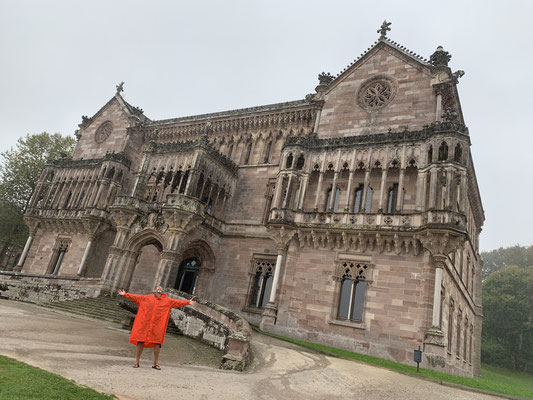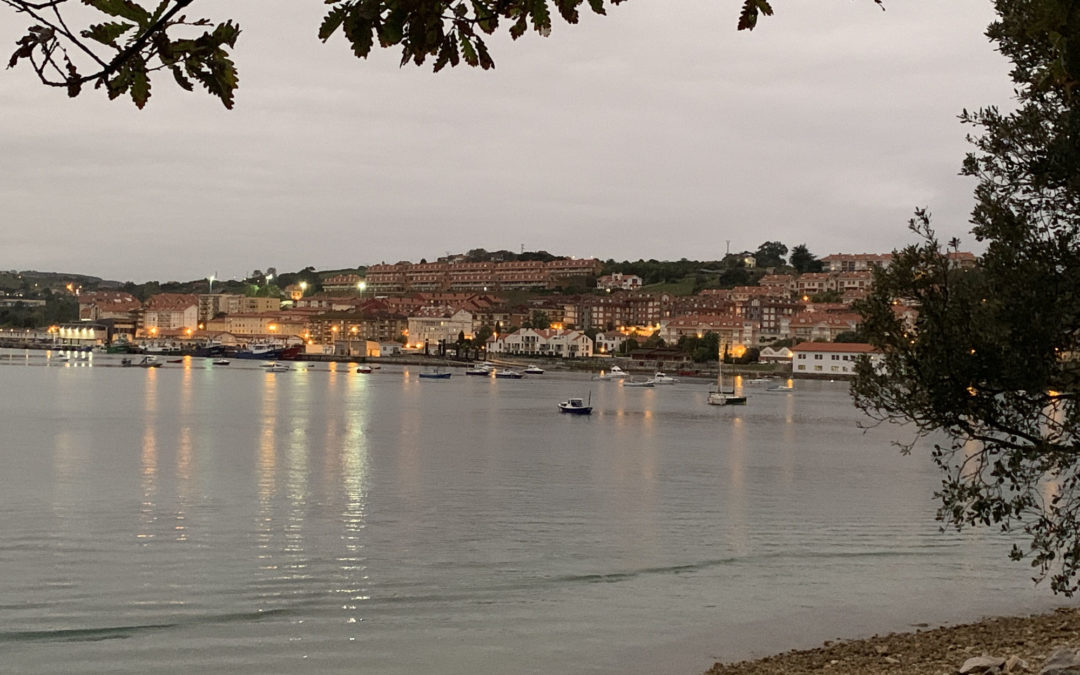
This is exactly how I always imagined wintering in Spain: Dry and warm...
I have always read in various travel reports that travelers, far from home, miss the seasons and especially spring and autumn. - Sounds good, I thought. - But what does it look like in real travel?
The rain drumming on our roof wakes us up early in the morning. It accompanies us throughout the day. Torgit has a sore throat and I have a cold. But we dope ourselves up with ginger. - Today we drive via Torrelavega towards Comillas. Cantabria reminds me a little of my home in the Bergisches Land. The landscape is hilly to mountainous, it looks very green and it rains too. But here you can clearly feel that the economic crisis has hit this region harder. Coming from the Basque Country, a clear change is noticeable. - Our path is repeatedly lined with ruined buildings. The industry looks visibly outdated. Livestock farming, fishing and tourism seem to be the pillars of the economy.
We see ourselves as a pillar of the economy and do a bit of tourism - Once we arrive in Comillas, we drive to the beach. We have breakfast in the van with the windshield wipers running. As there is no end in sight to the rain, I take off my shirt and go for a walk by the sea. But the looks on the faces of the few tourists in parkas clearly tell me that a naked upper body is not appropriate in this place, especially in this weather.
Speaking of befitting one's rank, you can literally feel that the Spanish royal family spent their summer vacation here at the end of the 19th century. The whole of Comillas looks a little sophisticated. You can sense that various architects wanted to leave and have left their mark in the Modernisme style. - I find it particularly exciting that what was once considered modern now exudes a glamorous, somewhat old-fashioned charm. - What will the generations after us think of the Bauhaus architecture that is currently so fashionable?
On our journey into the past, we first visit the cemetery, with its angel standing guard over the entrance. Here we are all to ourselves. - Even the name: Cementerio Ruta Modernista, has a certain glamor, doesn't it? - If you have to be buried, then this spot, with a clear view of the sea and the "Monument to the Marquis de Comillas", is certainly not a bad place. The "Casa del Duque de Almodóvar del Río" and the Pontifical University of Comillas are also in view.



Next, we discover the palace of Sobrellano. Despite the rain, we decide to take a few steps up. The building, built in neo-Gothic style, impresses with its color contrasts. I try to blend in with my rain cape. Even in the pattering rain, this place has a charm all of its own.
Is there more to discover in Comillas? We do a little googling. - We are suitably enthusiastic and want to take a look at Gaudí's country house "El Capricho". The sat nav shows us two routes. Apparently there are two routes. We try our luck. But even the first route makes us skeptical. The path gets narrower and worse. - Hopefully no cars will meet us here. - Suddenly we see two tail lights in the rain. There is a vehicle in front of us trying to turn around. The reason, a roadworks site. For us, too, this means backing up slowly in order to turn if possible. Suddenly I almost end up with a tire in the ditch. I pull the handbrake at the last second. Now I have to start up again very, very slowly. But it goes well. We manage to turn around in the next hairpin bend. - So we take the other route. But this also turns out to be difficult. First, I drive up the mountain from the other side and have to reverse twice due to oncoming traffic. Then the road becomes narrower and narrower and leads through small alleyways. At the end of one alley, it seems to make a ninety-degree turn. A car slowly backs out of it. The Capricho lies in a dead end. We have to back up again to look for a way to turn around. In the meantime, a car is behind us. It also tries to turn and gets stuck in the front of a house. Above us, we hear the Spanish curses of a local resident. Now we understand the sign "solo para residentes". Our attempt to turn around takes time. Backwards, forwards, backwards, move a few planters and onwards, forwards, backwards. After a few attempts, we are free again and glad that Hector has escaped unscathed. - What would our friend Uwe say? "I'm sure it would still be nice if I wasn't there" - that's how we see it now with "El Capricho". It was one hell of a Gaudí.
We prefer to go to San Vicente de la Barquera. Camping el rosal is located between two beaches that are considered surfing hotspots.
I park Hector with a direct view of the bay. But Torgit comes around the corner with a veto. "Why do I have to park so close to the precipice (two-metre embankment) again and not park like everyone else?" - My ego suitably bruised, I park again. As soon as we're parked, the space I had in mind is occupied by a couple of surfers - we're also wedged in on the other side.
So much for that. - Torgit then realized it too.


Hector's insight of the day: "You don't always have to be the center of attention, you can also sit sometimes".
*PS: We don't so much miss the seasons. - What we miss is variety in our food. Anyone who knows us also knows our motto: Food makes you happy. - The vegetables in France were great. But the selection of sausage, cheese and above all bread seems to be unique in Germany. Torgit loves Spain. But her relationship with the French baguette was already disturbed. The local pan blanco doesn't make it any better, but...
Torgit approaches this issue differently, but no less emphatically. She writes a public letter directly to Spain:
"Dear Spain,
I've always liked you very much and we've spent many wonderful times together. I think I was 5 years old when we met. It would almost have been the first and last time if my father hadn't pulled me out of the sea again, into which the wave had dragged me while I was playing on the beach. - I got to know and love your cultural side during the school trip to Barcelona. - You gave me access to Spanish artists. - The Mallorca package vacation with Doris was the big wide world back then - two weeks in summer, for which you saved the whole year. I've loved Palma ever since - the family vacations on the Costa de la Luz, with fine golden sand, were Atlantic and always very beautiful. - With the round trip through Andalusia, you completely wowed me. I had pippi in my eyes in the Alhambra. So incredibly beautiful!
But now we have a problem. After 3 weeks in France, I was already over the baguette. Even though it was so incredibly delicious. Especially this one, for which I felt like I was the 20th person in the queue in the alley in this tiny bakery in a small village that we happened to pass by and whose name I've forgotten again, while the organ played so beautifully in the little church next door. So I had time to enjoy the market around me with its amusing range of everything from mattresses to slatted frames. But, as I said, this was in France.
There's almost nothing like a good loaf of bread. However, we Germans are very spoiled when it comes to bread, especially because of the large selection. I find it difficult to eat the same bread for weeks on end. And now I'm supposed to keep eating just this one loaf of bread? I might be able to cope if this bread was served to me in the form of pintxos like in Bilbao. With a delicious txakoli. But this thing that I buy here in the supermarket and that Hector crumbles up so badly that my best man in the world gets in a bad mood is not acceptable. So, make a little effort, otherwise your Pan Blanco and I won't be friends. In happy anticipation, Torgit"


Recent Comments